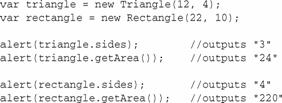Home >Web Front-end >JS Tutorial >Javascript inheritance implementation example_javascript skills
Javascript inheritance implementation example_javascript skills
- WBOYWBOYWBOYWBOYWBOYWBOYWBOYWBOYWBOYWBOYWBOYWBOYWBOriginal
- 2016-05-16 18:48:111108browse
1. 创建基类
首先考虑Polygon类。哪些属性和方法是必需的?首先,一定要知道多边形的边数,所以应该加入整数属性sides。还有什么是多边形必需的?也许你想知道多边形的面积,那么加入计算面积的方法getArea()。图4-3展示了该类的UML表示。

图 4-3
 在UML中,属性由属性名和类型表示,位于紧接类名之下的单元中。方法位于属性之下,说明方法名和返回值的类型。
在UML中,属性由属性名和类型表示,位于紧接类名之下的单元中。方法位于属性之下,说明方法名和返回值的类型。
在ECMAScript中,可以如下编写类:

注意,Polygon类不够详细精确,还不能使用,方法getArea()返回0,因为它只是一个占位符,以便子类覆盖。
2. 创建子类
现在考虑创建Triangle类。三角形具有三条边,因此这个类必须覆盖Polygon类的sides属性,把它设置为3。还要覆盖getArea()方法,使用三角形的面积公式,即1/2×底×高。但如何得到底和高的值呢?需要专门输入这两个值,所以必须创建base属性和height属性。Triangle类的UML表示如图4-4所示。
该图只展示了Triangle类的新属性及覆盖过的方法。如果Triangle类没有覆盖getArea()方法,图中将不会列出它。它将被看作从Polygon类保留下来的方法。完整的UML图还展示了Polygon和Triangle类之间的关系(图4-5),使它显得更清楚。

在UML中,决不会重复显示继承的属性和方法,除非该方法被覆盖(或被重载,这在ECMAScript中是不可能的)。
Triangle类的代码如下:


注意,虽然Polygon的构造函数只接受一个参数sides,Triangle类的构造函数却接受两个参数,即base和height。这因为三角形的边数是已知的,且不想让开发者改变它。因此,使用对象冒充时,3作为对象的边数被传给Polygon的构造函数。然后,把base和height的值赋予适当的属性。
在用原型链继承方法后,Triangle将覆盖getArea()方法,提供为三角形面积定制的计算。
最后一个类是Rectangle,它也继承Polygon。矩形有四条边,面积是用长度×宽度计算的,长度和宽度即成为该类必需的属性。在前面的UML图中,要把Rectangle类填充在Triangle类的旁边,因为它们的超类都是Polygon(如图4-6所示)。

图 4-6
Rectangle的ECMAScript代码如下:



注意,Rectangle构造函数不把sides作为参数,同样的,常量4被直接传给Polygon构造函数。与Triangle相似,Rectangle引入了两个新的作为构造函数的参数的属性,然后覆盖getArea()方法。
3. 测试代码
可以运行下面代码来测试为该示例创建的代码:

这段代码创建一个三角形,底为12,高为4,还创建一个矩形,长为22,宽为10。然后输出每种形状的边数及面积,证明sides属性的赋值正确,getArea()方法返回正确的值。三角形的面积应为24,矩形的面积应该是220。
4. 采用动态原型方法如何?
前面的例子用对象定义的混合构造函数/原型方式展示继承机制,那么可以使用动态原型来实现继承机制吗?不能。
继承机制不能采用动态化的原因是,prototype对象的独特本性。看下面代码(这段代码不正确,却值得研究):



The above code shows the Polygon and Triangle classes defined with dynamic prototypes. The error is in the highlighted code that sets the Triangle.prototype property. Logically this position is correct, but functionally it is invalid. Technically speaking, the object has been instantiated and linked to the original prototype object before the code is run. Although using very late binding allows modifications to the prototype object to be reflected correctly, replacing the prototype object will not have any impact on the object. Only future instances of the object will reflect this change, making the first instance incorrect.
To correctly use the dynamic prototype implementation inheritance mechanism, a new prototype object must be assigned outside the constructor, as shown below:

This code works because the prototype object is assigned a value before any object is instantiated. Unfortunately, this means that this code cannot be completely encapsulated in the constructor, which is the purpose of dynamic prototypes.
Related articles
See more- An in-depth analysis of the Bootstrap list group component
- Detailed explanation of JavaScript function currying
- Complete example of JS password generation and strength detection (with demo source code download)
- Angularjs integrates WeChat UI (weui)
- How to quickly switch between Traditional Chinese and Simplified Chinese with JavaScript and the trick for websites to support switching between Simplified and Traditional Chinese_javascript skills

